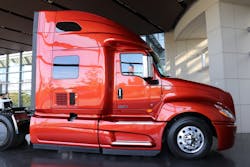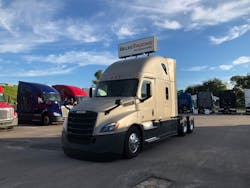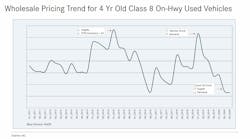Jamie Hagen’s rise from owner-operator to owner of a small but ambitious fleet called Hell Bent Xpress is a familiar one. In 1992, then a teenager, the South Dakota native started driving his dad’s newly acquired Class 8 truck — a rusty 1978 Ford Louisville. And since that first truck, which he joked had a hole in the floor for “air conditioning,” Hagen hasn’t looked back.
He has always looked to improve his equipment, though. Within three years, he ventured out on his own and purchased a used 1992 Freightliner FLD.
Hell Bent Xpress was incorporated in 2010, and Hagen has slowly grown to a fleet of four 2020 Mack Anthems, with a model year (MY) 2022 arriving in June. It’s a slow trudge, and Hagen, a meticulous bookkeeper, tries to stretch every penny over every mile. This, along with a decent Twitter following, earned him a spot in Mack Truck’s #Mackonomics social media campaign, in which Hagen and another Mack customer track their fuel savings efforts and share their experiences online.
The campaign also provided insight on Hagen’s first-hand experience operating a Mack Anthem spec’d with the HE+ efficiency package. This package features the integrated powertrain MP8 diesel engine’s turbo compounding and energy recovery abilities paired to the mDrive automated manual transmission. Mack found fuel efficiency with the HE+ improves by 13% over the base model Anthem. Hagen reported the “Mackonomics” truck has averaged 8.85 mpg over 23 months and 219,000 miles, even cresting 10 mpg for a summer stretch.
Now the fleet owner/driver has found himself at a crossroads. The stickler for efficiency — who prefers to get the latest lustrous equipment — has been offered a chance to buy 13 used 2020 Mack Anthems with the HE+ package from an acquaintance who wants to transition to a pure Volvo Trucks fleet. (Volvo Group owns both OEMs.)
Each used truck would cost about a quarter of a new truck while having the key specs Hagen seeks. Those savings could be allocated to the drivers needed to fill the new seats.
A concern for Hagen, however, is that these trucks would have on average 200,000 miles on them when handed over, plus the wear and tear associated with that. That means he will pay sooner for new brakes and tires, while having fewer years backed by warranty. Plus, he will get less back when he trades them in compared to a newer truck. Truck depreciation varies but could be 20% the first year and 10% or more every year after.
“Even if I don't end up purchasing all this equipment, just the thought of it coming at me has opened up my eyes,” Hagen said, because he was not expecting trucks with these more recent efficiency and technology improvements to even be available so soon.
This is becoming a familiar dilemma among small fleets: The struggle to grow in a volatile economy with limited capital, while attending to drivers’ needs for comfort and safety. Four years ago, the choice was clear-cut. To keep drivers in the seats and get the best fuel economy, a forward-looking fleet goes new every time. Because of several advances, such as powertrain improvements and the addition of advanced driver assistance systems, a brand new MY 2018 truck held a clear edge over a comparable MY 2014. The only hitch was affording the down payment, typically 20%.
In 2021, that edge has softened, because the technology gap is far more narrow now. This can be attributed in part due to continually stringent emissions regulations which have already significantly improved fuel economy and efficiency and the industry’s push to reduce accidents and improve safety through the adoption of advanced driver assistance systems (ADAS).
OEMs have also introduced better fuel efficiency through integrated powertrains and aerodynamic fairings in models since 2017. Large on-highway fleets usually cycle new trucks every three to five years, so more of these, including the Anthem, Freightliner’s newer Cascadia, and Navistar’s International LT are entering the secondary market.
It leaves company leaders such as Hagen several more factors to consider when deciding if new or used trucks, or a combination of both, are the most prudent choice.
Maintenance mitigation
Any fleet owner knows the importance of uptime and total cost of ownership. They also understand that even as less reliable trucks may cost less upfront, overall maintenance costs, including replacement parts, repairs, and unavailability of the vehicle, add up.
Steve Tam, vice president at ACT Research, noted fleets are becoming more sophisticated at accounting for the expenses made over the vehicle life and overall cash flow, as opposed to the monthly payment and fuel bill.
“There is a collective increasing cognizance of that type of analysis,” he said. This is a reason large fleets will sell trucks at four years and 400,000 miles or shift them to the regional market, where trucks with potential downtime issues can be serviced at or near the home base more quickly than one that broke down five states away.
Remote diagnostics, which started appearing more on trucks in the last four years, can help fleets venture farther, giving fleets advance warning for potential component failures. Through this technology — comprising sensors attached to vital components paired to telematics platforms and sent to drivers dashes and manager dashboards —a truck tells you when it is not feeling right. The system alerts the operator if differential pressure or rpm are out of normal operating range and estimates when a failure may happen. Ideally, this foresight gives fleets enough time to adjust schedules and routes to cover downtime.
“Maintenance has and continues to become more predictive than reactive,” said Olen Hunter, director of operations for North America for Paccar Leasing Company, which has a global inventory of 40,000 Kenworth, Peterbilt, and DAF trucks. Paccar Leasing also provides short-, medium- and long-term leases as well as sells off older equipment. “You don't get that with the old technology. The trade-off is with today's new trucks, you've got sensors on sensors. The newer technology might have more downtime initially until you work the bugs out.”
Overall reliability and peace of mind more than make up for possible delays of fleets unfamiliar with the technology. “Once you get the sensor stuff figured out, it's pretty simple and it's pretty efficient,” Hunter said.
This is one of the biggest advantages the new crop of pre-owned trucks have that previous ones did not, said Allen Croft, director of used trucks for CSM Truck, a dealer of Kenworth trucks, with locations in five states. He noted Kenworth’s TruckTech+ came standard on 2019-2020 models. Any vehicle owner can renew the annual subscription.
Croft explained that a shop can remotely diagnose a problem based on the fault codes that come up. Then, the dealer can tell the driver if the issue can be fixed after the load is delivered, or whether the truck must get to a dealer ASAP to prevent a severe failure.
And if a powertrain component, for example, were to need extensive repairs, the secondary owner is protected because original equipment manufacturers have started to offer extended warranties. A 2018 model will still be covered by a five-year warranty.
“When making a purchase and deciding between new and used, fleets weigh the lower purchase price of a used vehicle with the expected increase in maintenance cost of that used vehicle,” said Tony Stinsa, vice president of used truck for Navistar, which offers OnCommand Connection for telematics and remote diagnostics. “With available extended warranties, the operating cost of a late-model used vehicle can be similar to, or even better than, that of a new vehicle.”
What these late-model used trucks have going for them is that the manufacturer and dealer network have had these past few years to work out any of those bugs. Engineers and technicians now have the experience to recognize what problems a sensor may have caused and have likely released an over-the-air (OTA) update to fix the issue.
Mack Trucks, which now has driver-initiated OTA updates for GuardDog Connect, has noticed the severity of complaints has diminished with the Anthem since it launched in 2018.
“What we've heard the most is about [minor] problems, like the mirrors rattling or something like that,” said Stu Russoli, Mack highway product manager. “And when you start hearing about all the little problems, that lets you know that the big problems aren't happening, so it's always a good sign.
“By the time you're getting your used truck, it's all fine-tuned, and you should be good to go,” he added.
Regardless, any fleet should factor in that maintenance costs will be higher with used trucks, along with diminishing fuel economy, over time.
“The cost of maintenance goes from being a linear function to more of a curvilinear, or even an exponential function,” Tam said. “The older it gets, the more and more expensive it is to maintain the truck.”
Equipment demand
The most obvious business case for buying a used truck is that when freight rates are higher and carriers can make more money per load, the need for more capacity rises.
“Freight volumes and rates are really driving what's going on in the used-truck market,” Paccar Leasing’s Hunter said. “When freight volumes jump, these really big fleets will attack a portion of that volume with their own assets and to take advantage of the peaks, will go out and get a third party, whether it's an older driver or a small fleet, to haul that extra freight.”
These smaller fleets and owner-operators prefer used trucks, and the dealers who spoke with FleetOwner said large fleets have also started to add some late-model used trucks to increase capacity.
A buyer could wait several months for the perfect new truck with remote diagnostics, a top-of-the-line safety system, and most fuel-efficient powertrain, or spend weeks trying to find the lowest-priced used truck. All the while, that is one less moneymaker in the fleet.
“You can make that $3,000 up by just having that truck,” Croft explained. “If you don't buy the truck, and you don't put somebody in it to drive it, you're not making that money. The money that the truck is costing you now is minute in the grand scheme of the revenue that truck is going to generate down the road.”
After researching and spec’ing a new truck, it could take several months for a new truck to hit the road. Because of factory shutdowns due to COVID-19, OEMs and suppliers were delayed last year and orders in 2020 were pushed back even further, though that is less of a problem now.
“In a market like we are currently seeing, when factory lead times are longer than normal, a late-model year used vehicle with warranty coverage remaining or available for purchase can provide an immediate option,” Stinsa said. “Historically high freight rates, and operating cost comparable to new trucks, are making late-model (used) International LTs the first choice of many fleets.”
The capacity crunch has pushed new truck customers to contemplate pre-owned equipment, though there are some caveats.
“Used trucks are ‘as-is,’ while a new truck can be customized to anything the customer wants,” offered Dave Kriete, president and CEO of Kriete Truck Centers in Milwaukee, Wisc., a dealer of Mack, Volvo and Hino trucks. “Oftentimes, if a customer has the means and is willing to spend $125,000 for a used truck that is sort of their spec, they may find greater value in spending more money to get the exact truck they want.”
Hagen, for instance, is getting Mack Command Steer on his Anthem being delivered in June. He had already gone down to Greensboro, N.C., to demo the feature, which defers the physical effort of turning the wheel to an electric motor on the steering column, reducing muscular fatigue.
“Until you've used one, you don't think it's worth it,” Hagen emphasized. “It is an absolute no-brainer. I will pay for that upcharge every time, and every driver, I guarantee, will be like that.”
Because it reduces the strain on drivers by up to 30%, Mack sees this as a driver retention tool. With turnover at some fleets near 90% annually and onboarding a new driver reaching $10,000, the upgrade could steer a nomadic driver to settle down.
“If a driver had that truck [with Command Steer], he would think twice about hopping fleets if he was going to lose that truck,” surmised Tim Wrinkle, Mack’s construction product manager. The steering-assist system is available on Granite axle-back models as well as Anthems.
Another selling point for new trucks is getting the highest level of ADAS, such as Detroit Assurance 5.0, which offers Level 2 automation through lane keep assist and collision mitigation. A 2019 Freightliner would have Detroit Assurance 4.0, which in 2018 Daimler Trucks North America reported was being spec’d on 75% of new builds.
Bendix Wingman Fusion 2.0, the safety system found on a Kenworth T680, also appeared on more recent trucks.
In 2019, Volvo Trucks made its Active Driver Assist 2.0 safety system standard on new Volvo VNR and VNL trucks. These should start appearing on used lots soon.
Josh Sluder, corporate used-truck manager at Volvo dealer Bruckner Truck Sales, said safety has usurped drivetrain and horsepower in importance for buyers. For an owner-operator or small fleet, it could be the difference between getting a contract or not.
“FedEx requires it,” Sluder said. “Even leasing on to be an owner-operator under someone else's authority, they have to have the safety features on there.”
He estimated having a safety system adds $3,000 to $4,000 on the used-truck value and could determine if a truck sells, as does the leftover warranty.
“Those five-year-old, 500,000-mile trucks with no extended coverage left stack up quickly and are everywhere,” Sluder said.
Availability
These late-model trucks will also be plentiful in the next few years. In 2018, a record-setting year, Class 8 shipments topped 490,100, according to FTR. Again in 2019, the industry saw 349,053 Class 8 shipments. The shipments in 2020 dropped 44% from 2019 levels and 60% down from 2018. The trickle of quality used trucks today will turn into a deluge over the next few years
“We have trouble keeping used trucks on our lot,” said Chad Seth, director of truck sales at Rihm Kenworth. “Demand is much higher, so we're constantly trying to find that used inventory out there.”
Seth said used late models have become attractive because of their automated manual transmissions and collision mitigation systems.
He noted many customers have been inquiring about 2017 Freightliner Cascadias, which the dealer also sells. Daimler Trucks North America has seen the same.
“Prices are on the rise for used trucks right now,” said Mary Aufdemberg, president and general manager of Daimler Trucks Remarketing, who expects prices to stay higher for the first half of the year. “Inventories are decreasing in the marketplace, but we do expect supply to keep coming.”
A MY 2018 Cascadia, what DTNA calls the ‘new’ Cascadia, spec’d for optimal efficiency could be 19% more fuel-efficient than an older model, DTNA said.
“Not everybody's going to be able to get their hands on them, but for any of the used-truck customers that really like to be a technology leader, the ‘new’ Cascadia is going to be something they're going to want to keep their eyes on,” Aufdemberg noted.
Decision time
Hagen was facing a life-changing choice. “Even though these trucks are kind of high priced, they’re still cheaper than a new one,” he said.
“The biggest thing is being able to purchase more equipment for the same money.”
A similar investment on new trucks would yield three fewer power units. He could nearly triple his fleet size but also compound his maintenance hassles.
“It’s a huge leap from five to 18,” Hagen mused. This extra capacity would expedite Hell Bent Xpress’ need to find drivers, as well as require upsizing to a shop to accommodates the additional units.
After a week mulling options, Hagen decided to purchase three new 2022 Mack Anthems, which will include the HE+ powertrain and Command Steer. He may have been able to procure fewer than 13 used trucks, but the newer trucks will actually arrive sooner.
And they will all come with nearly zero miles and unlimited potential.
“I chose this path of slower growth for my fleet and myself as an entrepreneur,” Hagen said. “After all, I'm just one man.”
About the Author
John Hitch
Editor
John Hitch is the editor-in-chief of Fleet Maintenance, providing maintenance management and technicians with the the latest information on the tools and strategies to keep their fleets' commercial vehicles moving. He is based out of Cleveland, Ohio, and was previously senior editor for FleetOwner. He previously wrote about manufacturing and advanced technology for IndustryWeek and New Equipment Digest.






